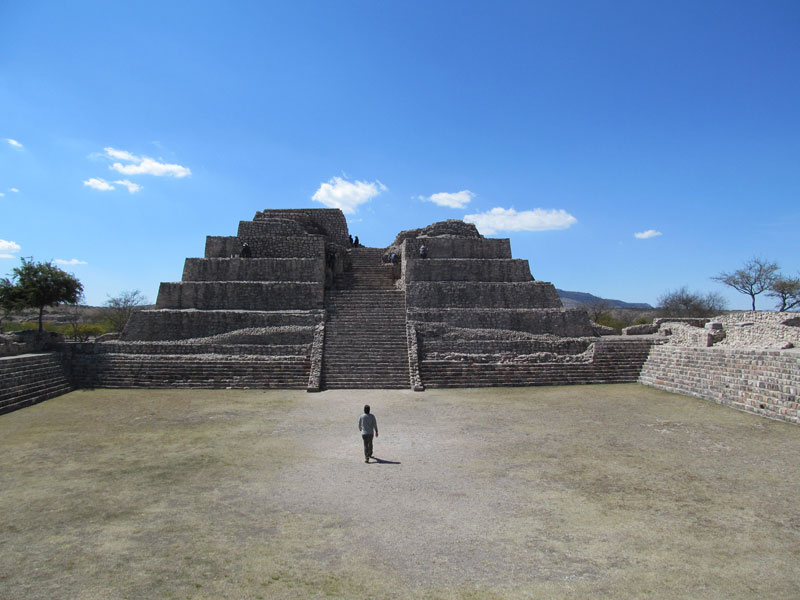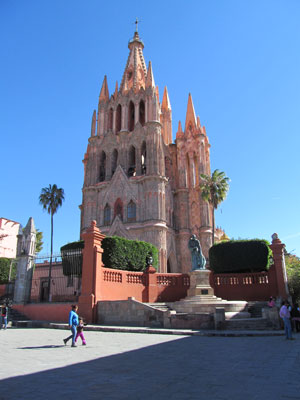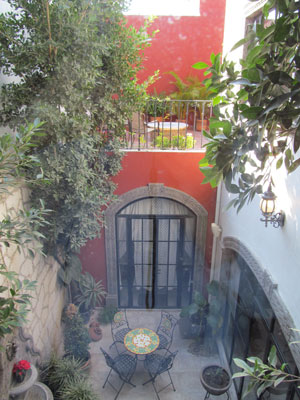Bajío sites: La Cañada de la Virgen
This item appears on page 53 of the November 2015 issue.
(Part 1 of 3 on central Mexico)
About a 4-hour drive north of Mexico City (México, D.F.) is a semiarid region punctuated by hills and valleys called the Bajío. It’s where three of Mexico’s most interesting destinations are located: San Miguel de Allende, Guanajuato and Santiago de Querétaro.
My husband, Paul, and I traveled to San Miguel de Allende to exchange New York’s especially brutal winter for San Miguel’s spring-like temperatures, which averaged about 70°F during the day for our entire month there.
We also wanted colonial churches embellished with lavish baroque-like interiors, plus crafts, art galleries and museums and what Paul calls “good eats,” Mexican and otherwise. San Miguel de Allende, with a large population of foreign residents as well as “snowbirds” like ourselves escaping winter north of the border, is a cosmopolitan town of about 70,000 offering many and varied amenities.
We found what we had hoped for in abundance, but what we did not expect were pre-Hispanic archaeological sites.
Most books don’t mention archaeological sites in this area of Mexico at all. As it turns out, recent archaeological exploration and excavation — much of it within the last 25 years — has uncovered hundreds of sites in the Bajío. One estimate is that there are over 1,000, including four major sites: El Cóporo, Peralta, Plazuelas and La Cañada de la Virgen.
We visited three of these four, including the foremost Bajío site, La Cañada de la Virgen (the Canyon of the Virgin).
The Bajío people
La Cañada de la Virgen lies 15 miles southwest of San Miguel de Allende in a dramatically scenic area of deep canyons and cacti. Although there were indigenous peoples living there long before the site existed, it was the ancestors of the present-day Otomis who succeeded these earlier people, who flourished there between approximately AD 500 to 1000. These “Bajío people,” as our guide called them, built the structures you now see at La Cañada.
La Cañada was both a ceremonial site and an astronomical observatory. Warriors lived there as did priests, who were extremely important in the society. They studied the movements of the sun, moon and stars to determine the best times to plant and harvest — essential in an agrarian society with a large population farming in the surrounding valleys.
Through the placement of their pyramids, the priests were able to determine celestial movements and thus predict optimal sowing time.
The site is compact and is entered through an enclosing wall with only one entrance, a defensive measure.
The first structure reached, Complex B, the House of the Longest Night, consists of a pyramid and an adjacent large sunken patio. This complex was aligned with the winter solstice, the shortest day/longest night of the year.
Several skeletons were found there, but it is not known whether they were sacrificed or whether they died naturally and were buried there.
Adjacent to Complex B lies Complex C, as yet unexcavated.
Pre-Hispanic observatory
A few steps away is Complex A, the House of the Thirteen Heavens, the most important structure at La Cañada. This was the principal observatory, aligned with the rising and setting sun.
There is a very large sunken patio with stepped platforms on three sides. When filled with water, it would have reflected the movement of the moon against the night sky. On the fourth side of the patio is the stepped pyramid of six tiers, rising 53 feet and once topped by a temple.
In the late 1940s, the temple was dynamited by a misguided local priest who hoped to deter his flock — those who still used this pyramid for their religious observances — from the old ways.
Nineteen burials, mostly of the eighth and ninth centuries AD, were discovered in this complex, including one of a person who died in the eighth century BC and who was moved to this pyramid about a thousand years after his death. He was probably an important chief, warrior or priest to warrant his reburial there.
Nearby is Complex D, the House of the Wind, with a round temple, rare in Mesoamerica. Round structures were almost always associated with Ehecatl, the Mesoamerican wind god. There’s also a botanical garden planted with hundreds of plants native to the Bajío region. The plants are divided into sections depending on their use: medicine, food, construction material, etc.
La Cañada de la Virgen is open from 9 to 3, Tuesday to Sunday. Visitors must join a tour group even if arriving by private car. Tours are given hourly, beginning at 10. From the visitors’ center there is a short bus ride, followed by a long hike of one kilometer to the site, itself.
In our opinion, the best way to visit La Cañada is to contact Coyote Canyon Adventures (San Miguel de Allende, Guanajuato, Mexico; phone, from the US, [+52] 415 154 4193, www.coyotecanyonadventures.com), which will reserve transportation from San Miguel de Allende to the archaeological site and arrange for a guide. We paid $55 per person.
Colonial San Miguel de Allende
San Miguel de Allende was our winter refuge from mid-January to mid-February in 2014. We never lacked for things to do, although we deliberately slackened our pace to savor this lovely town, especially its many cafés and restaurants. Our favorites were La Posadita, Tío Lucas, Food Factory La Aurora, Hank’s New Orleans Café & Oyster Bar, La Bella Italia and, in the boutique hotel Rosewood San Miguel de Allende, the Luna Rooftop Tapas Bar.
As for sights and experiences, here’s our personal top half-dozen list: strolling around San Miguel’s main plaza, called El Jardín; dropping in for visits at the iconic Parroquia de San Miguel church and to Ignacio Allende’s family home (he was one of the heroes of Mexico’s War of Independence); Centro Cultural Ignacio Ramírez to see David Alfaro Siqueiros’ immense unfinished mural; the fabulous mask collection in the Casa de la Cuesta B&B (Cuesta de San José 32, Azteca; phone +52 415 154 4324); the fresco-covered interior of the Church of Jesús Nazareno in Atotonilco, eight miles from San Miguel; the nature walk along a canyon ridge among cacti at El Charco del Ingenio, and, back in San Miguel, the upscale Fábrica La Aurora for elegant shopping and gallery browsing in a former textile factory.
Also on our must-see list in the Bajío are Guanajuato and Querétaro, each about an hour’s drive from San Miguel and each deserving more than a day trip. Two or three nights in each would be best.
If you go…
When visiting San Miguel de Allende, try not to skimp on time. Allow at least three nights. A week is better. A month in the middle of a north-of-the-border winter is best if you really want to “experience” this colonial town.
We rented a lovely house, Casa Tatanacho, in the Guadalupe section of San Miguel, about a 7-minute cab ride from El Jardín. The house came with an open-plan living room/dining room/kitchen, four bedrooms, three full baths, two half baths, a shady patio and two spacious sunny terraces full of greenery, flowers and a resident hummingbird. We had wonderful views of the Parroquia from the rooftop terrace.
The monthly rent was $3,500. We rented through an excellent agency, Serenity Vacation Rentals (Laredo, TX; 970/300-4820, www.serenity sanmiguel.com), which we would rate A+ in terms of response time and helpfulness, even down to doing some shopping for us in advance of our arrival and arranging for private drivers to take us to Guanajuato and Querétaro and back.
Coming up, Julie visits two more pre-Columbian cities in the Bajío: Las Plazuelas and Peralta.



